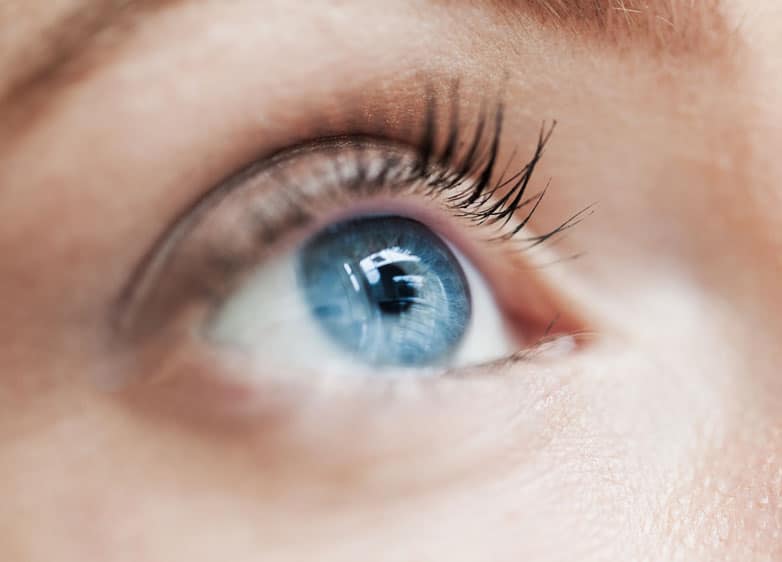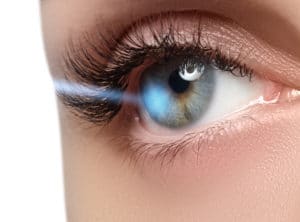Photorefractive Keratectomy (PRK)
in Jacksonville, FL
One of the cornerstone goals at Jacksonville Eye Center is to help each of our patients enjoy the best possible vision at every age. Refractive error related to a change in the shape of the eye affects how well one can see up close or far away. Typically, refractive errors such as presbyopia, nearsightedness, and farsightedness are corrected using external lenses, eyeglasses or contacts. We are proud to offer a different option: Photorefractive Keratectomy (PRK).
 What is Photorefractive Keratectomy (PRK)?
What is Photorefractive Keratectomy (PRK)?
Photorefractive Keratectomy is a type of laser eye surgery that corrects common refractive errors. The procedure focuses on reshaping the cornea at the front of the eye through which light travels to reach the retina. During PRK surgery, a pulsing beam of cool ultraviolet light modifies the cornea to achieve the appropriate contouring.
Who is a candidate for PRK surgery?
There are several characteristics that may indicate candidacy for PRK surgery. These include:
- Corneal thickness. Patients who have a thinner cornea may be good candidates for PRK because no flap is created during the procedure.
- Vision prescription. PRK may be preferred for patients with mild, moderate, or myopia (nearsightedness).
- Lifestyle. The work and hobbies in which a patient engages may indicate that PRK is a better option for laser vision correction. Contact sports and occupations in which eye injuries are more likely may make photorefractive keratectomy more appropriate.
The eye doctors at Jacksonville Eye Center conduct a thorough consultation and initial examination to determine which long-term vision correction is best for each patient.
What our Patients say
“My experience with the Jacksonville eye center just can not be beat. I’ve lived with terrible eyesight my entire life. Dr schnipper evaluated me for the best corrective eye surgery possible. The Dr and his staff are top notch, courteous professional and friendly. I would strongly recommend them to friends and family with eye care needs. Thank you Dr, and thank you to your team for helping me.” – Jeff B.
What is the Difference Between PRK and LASIK Surgery?
PRK and LASIK are relatively similar procedures. Each is intended to correct refractive errors that force a person to rely on eyeglasses or contact lenses. PRK was developed before LASIK and has been safely performed for many years, though studies indicate that the recovery from PRK is slightly longer than its successor.
Both PRK and LASIK work by reshaping the cornea at the front of the eye. Each does so with an excimer laser. Where they differ is in the creation of a flap in the cornea.
LASIK Eye Surgery
During LASIK, a flap is made with a femtosecond laser. The flap of corneal tissue is then lifted so the corneal tissue can be accessed and reshaped with the excimer laser.
PRK
During PRK, the outermost layer of the cornea is removed completely, providing necessary access to the part of the cornea that needs to be reshaped. The layer of tissue, called the epithelium, grows back over the course of a few days after surgery.
Recovery also differs slightly between LASIK and PRK. Because a layer of tissue is removed during PRK, recovery involves the regrowth of new cells over the cornea. While this is ongoing, patients may experience mild discomfort and hazy vision. However, once the new layer of cells has covered the corneal surface, the results of PRK are comparable to LASIK.
Benefits of PRK
Both PRK and LASIK offer significant benefits for better vision. However, there are two aspects of PRK surgery that may be relevant to certain patients. In particular, studies suggest that PRK may be an optimal treatment option for individuals with dry eye as a coexisting condition to their refractive error. The corneal sensation is integral to tear production, and research has demonstrated a faster regeneration of corneal density after PRK compared to LASIK. Therefore, the risk of post-treatment dry eye syndrome may be decreased.
PRK is also beneficial for patients who lead an active lifestyle because the creation of a corneal flap leaves this part of the eye more vulnerable to injury.
How Does a PRK Procedure Work?
Like LASIK, the PRK procedure is performed on an outpatient basis. Patients are awake during treatment but may be given a mild sedative to help them relax. Before commencing with treatment, eye drops are administered to numb the surface of the eye. The eyelids are kept open with a small instrument called a lid speculum.
The patient is instructed to look at light within the excimer laser machine. This enables the doctor to observe the eye microscopically while pulses of light are directed at the cornea. When laser light comes into contact with the corneal tissue, microscopic layers are removed and the cornea is reshaped. To complete the procedure, the surgeon places a contact lens bandage over the cornea.
How Long Does a Photorefractive Keratectomy Procedure Take?
The entire procedure typically takes less than 30 minutes.
It is possible to have both eyes treated during the same visit or you can schedule each eye to be treated separately, one to two weeks apart.
Recovery after PRK surgery
A short resting period may take place in the office immediately after PRK surgery before a patient is released to be driven home by a friend or loved one. Patients may be prescribed topical antibiotics to apply during their short recovery period at home. Instructions for pain management are also provided. Most patients can maintain comfort using over-the-counter pain-relieving or anti-inflammatory medication such as Tylenol or Ibuprofen.
How Long After PRK Surgery Could I Drive Again?
Vision stabilization improves within the first three weeks after PRK treatment, at which time patients may resume driving. Full visual stability and clarity may not occur for three to six months.
Is PRK surgery painful?
Patients do not describe PRK as painful because numbing eye drops adequately desensitize the cornea before surgery. Some patients describe feeling a pressure sensation as the laser reshapes the cornea, but do not report this as uncomfortable. After surgery, pain medication can be used to reduce soreness that may result from the laser affecting deeper layers of the cornea.
Is a PRK Procedure Safe?
PRK is a common procedure that has been performed in the United States since 1995 and since the 1980s in other countries. The success rate for this method of corneal reshaping was high initially and has only improved as technological advances have enhanced the accuracy of laser therapy.
What will my vision be like after PRK surgery?
Results from PRK are similar to LASIK, with most patients achieving 20/40 vision or better. In many situations, 20/20 vision is restored. Having PRK does not mean that eyeglasses will never be needed again. Some patients continue to need a low prescription for reading or other tasks, and patients may still need eyeglasses in the future due to the natural aging of the eye (presbyopia).
Risks of PRK surgery
The potential for complications after PRK surgery is low. Some of the risks of surgery include infection and halos or glare around light when night driving. If this occurs, night driving may be enhanced with photochromic eyeglasses to reduce light sensitivity.
Schedule a Consultation
Discover how PRK can improve your vision. Contact our office at 904-355-5555 to schedule a consultation for laser vision correction. Jacksonville Eye Center serves Jacksonville, FL and surrounding areas.


 What is Photorefractive Keratectomy (PRK)?
What is Photorefractive Keratectomy (PRK)?